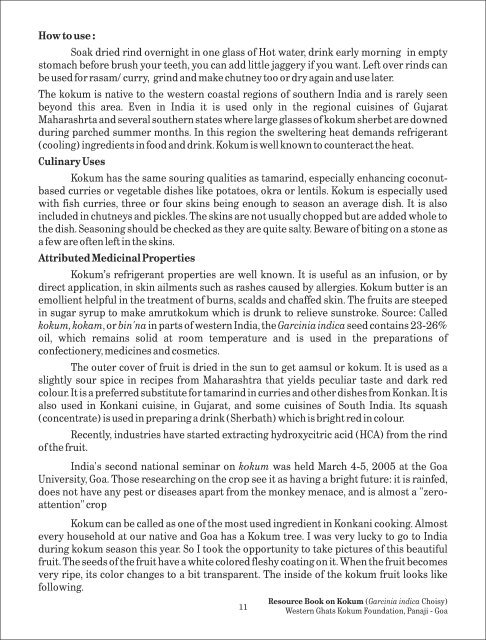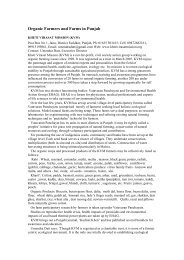Western Ghats Kokum Foundation - Organic Farming Association of ...
Western Ghats Kokum Foundation - Organic Farming Association of ...
Western Ghats Kokum Foundation - Organic Farming Association of ...
Create successful ePaper yourself
Turn your PDF publications into a flip-book with our unique Google optimized e-Paper software.
How to use :<br />
Soak dried rind overnight in one glass <strong>of</strong> Hot water, drink early morning in empty<br />
stomach before brush your teeth, you can add little jaggery if you want. Left over rinds can<br />
be used for rasam/curry, grind and make chutney too or dry again and use later.<br />
The kokum is native to the western coastal regions <strong>of</strong> southern India and is rarely seen<br />
beyond this area. Even in India it is used only in the regional cuisines <strong>of</strong> Gujarat<br />
Maharashrta and several southern states where large glasses <strong>of</strong> kokum sherbet are downed<br />
during parched summer months. In this region the sweltering heat demands refrigerant<br />
(cooling) ingredients in food and drink. <strong>Kokum</strong> is well known to counteract the heat.<br />
Culinary Uses<br />
<strong>Kokum</strong> has the same souring qualities as tamarind, especially enhancing coconutbased<br />
curries or vegetable dishes like potatoes, okra or lentils. <strong>Kokum</strong> is especially used<br />
with fish curries, three or four skins being enough to season an average dish. It is also<br />
included in chutneys and pickles. The skins are not usually chopped but are added whole to<br />
the dish. Seasoning should be checked as they are quite salty. Beware <strong>of</strong> biting on a stone as<br />
a few are <strong>of</strong>ten left in the skins.<br />
Attributed Medicinal Properties<br />
<strong>Kokum</strong>’s refrigerant properties are well known. It is useful as an infusion, or by<br />
direct application, in skin ailments such as rashes caused by allergies. <strong>Kokum</strong> butter is an<br />
emollient helpful in the treatment <strong>of</strong> burns, scalds and chaffed skin. The fruits are steeped<br />
in sugar syrup to make amrutkokum which is drunk to relieve sunstroke. Source: Called<br />
kokum, kokam, or bin'na in parts <strong>of</strong> western India, the Garcinia indica seed contains 23-26%<br />
oil, which remains solid at room temperature and is used in the preparations <strong>of</strong><br />
confectionery, medicines and cosmetics.<br />
The outer cover <strong>of</strong> fruit is dried in the sun to get aamsul or kokum. It is used as a<br />
slightly sour spice in recipes from Maharashtra that yields peculiar taste and dark red<br />
colour. It is a preferred substitute for tamarind in curries and other dishes from Konkan. It is<br />
also used in Konkani cuisine, in Gujarat, and some cuisines <strong>of</strong> South India. Its squash<br />
(concentrate) is used in preparing a drink (Sherbath) which is bright red in colour.<br />
Recently, industries have started extracting hydroxycitric acid (HCA) from the rind<br />
<strong>of</strong> the fruit.<br />
India's second national seminar on kokum was held March 4-5, 2005 at the Goa<br />
University, Goa. Those researching on the crop see it as having a bright future: it is rainfed,<br />
does not have any pest or diseases apart from the monkey menace, and is almost a "zeroattention"<br />
crop<br />
<strong>Kokum</strong> can be called as one <strong>of</strong> the most used ingredient in Konkani cooking. Almost<br />
every household at our native and Goa has a <strong>Kokum</strong> tree. I was very lucky to go to India<br />
during kokum season this year. So I took the opportunity to take pictures <strong>of</strong> this beautiful<br />
fruit. The seeds <strong>of</strong> the fruit have a white colored fleshy coating on it. When the fruit becomes<br />
very ripe, its color changes to a bit transparent. The inside <strong>of</strong> the kokum fruit looks like<br />
following.<br />
11<br />
Resource Book on <strong>Kokum</strong> (Garcinia indica Choisy)<br />
<strong>Western</strong> <strong>Ghats</strong> <strong>Kokum</strong> <strong>Foundation</strong>, Panaji - Goa





